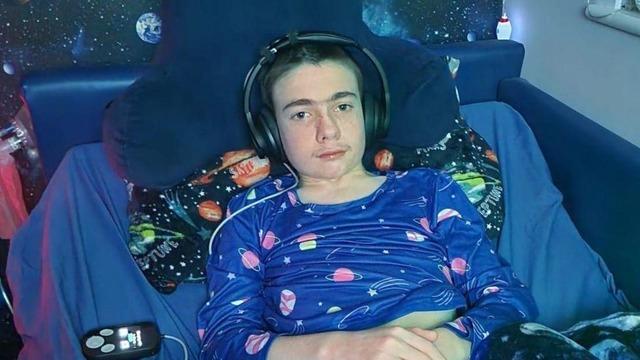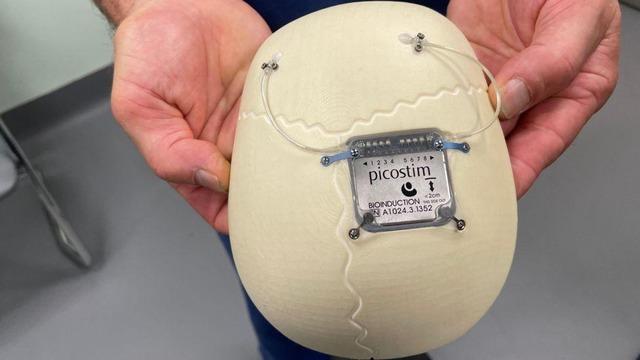The neurostimulator, which sends electrical signals deep into his brain, reduced the child’s daytime seizures by 80 percent.
His mother Justine told the BBC he was happier and had a “much better quality of life”.
The surgery was carried out last October as part of a trial at Great Ormond Street Hospital in Oran, London.
Oran has Lennox-Gastaut syndrome, a treatment-resistant form of epilepsy that began when he was three years old.
Since then, he had been having between 20 and 100 daily seizures.
We talked to Oran’s mother for the first time before the surgery. Epilepsy, he said, “robbed him of his entire childhood.”
He explained that Oran had various seizures in which he sometimes fell to the ground, shook violently and lost consciousness.
He said he sometimes stopped breathing and needed emergency medication to revive him.
Oran has autism and attention deficit hyperactivity disorder, but Justine says his epilepsy was by far his biggest disability: “I had a pretty bright three-year-old and within a few months of his seizures starting they deteriorated rapidly and he lost a lot of his skills.”
Oran is part of an epilepsy trial project evaluating the safety and effectiveness of deep brain stimulation in severe epilepsy.
Great Ormond Street Hospital, University College London, King’s College Hospital and Oxford University are involved in this project.
Picostim neurotransmitter was produced by the British company Amber Therapeutics.
HOW IS IT WORKING?
Epileptic seizures are triggered by abnormal bursts of electrical activity in the brain.
The device, which emits a constant pulse of current, aims to block or disrupt abnormal signals.
Before the surgery, Justine told the BBC, “I want him to find something of himself again in the blur of seizures. I want my son back.”
The surgery, which lasted approximately eight hours, took place in October 2023.
The team, led by consultant pediatric neurosurgeon Martin Tisdall, implanted two electrodes into Oran’s brain, up to the thalamus, a key relay station for neuronal information.
The margin of error in placement was less than a millimeter.
Its ends were connected to a 3.5-square-centimeter, 0.6-cm-thick neurostimulator placed in the space in Oran’s skull where the bone had been removed.
The neurostimulator was then screwed into the surrounding skull to secure it in place.
Deep brain stimulation has previously been tried for childhood epilepsy, but until now neurostimulators were implanted in the chest with cables extending up to the brain.
“This study hopes to allow us to determine whether deep brain stimulation is an effective treatment for this severe form of epilepsy, and also investigates a new type of device that is particularly useful in children because the implant is in the skull, not in the chest,” Martin Tisdall told the BBC.
“We hope this will reduce potential complications.” This includes reducing the risk of infection and device malfunction after surgery.

He was given a month to recover after the surgery. Then the neurostimulator was turned on.
Oran cannot feel this when the neurostimulator is on. It can charge the device via wireless headphones every day while doing things like watching TV.
We visited Oran and his family seven months after surgery. Justine said there had been a huge improvement in Oran’s epilepsy: “He is more alert and has no drop seizures during the day.”
Night seizures also become “shorter and less severe.”
“I’ll bring him back slowly.”
“We are delighted that Oran and his family have benefited so much from the treatment and that it has significantly improved his seizures and quality of life,” says Martin Tisdall.
Oran is currently taking riding lessons.
Although a nurse is nearby for oxygen, it has not been needed so far.
As part of the trial, three more children with Lennox-Gastaut syndrome will be fitted with deep brain neurostimulators.
Oran is currently receiving a constant electrical alert from his device.
But in the future, the team plans to enable the neurostimulator to respond in real time to changes in brain activity to prevent seizures when they are about to occur.
Justine said she was very excited about the next phase of the trial: “The Great Ormond Street team has given us renewed hope… The future looks brighter now.”
Oran’s family knows that his treatment is not a cure, but they are optimistic that he will come out of the shadow of epilepsy.
